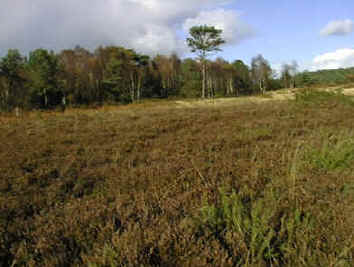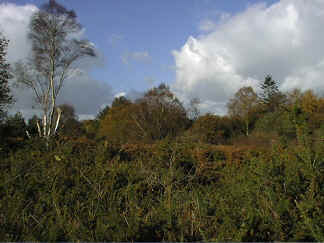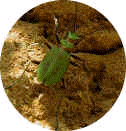 Heaths are wide open landscapes dominated by plants
such as Heathers, Gorse and heathland grasses and punctuated by scattered trees such as
Silver Birch. They are historic landscapes and
are essentially a man-made habitat. Heaths are wide open landscapes dominated by plants
such as Heathers, Gorse and heathland grasses and punctuated by scattered trees such as
Silver Birch. They are historic landscapes and
are essentially a man-made habitat.Heathlands occur on barren infertile land. The soils are usually sandy (and therefore free-draining), acidic and very low in plant nutrients. Because the soils are free-draining, they do not hold water for long and heaths are therefore often subject to summer droughts. Under such conditions, fires are a constant hazard, particularly as much of the vegetation is very resinous and hence, inflammable. A unique association of plants and animals adapted to withstand such inhospitable conditions has evolved to form the distinctive heathland community.
Superficially heaths may appear to be fairly uniform, but the associated plants and animals may vary greatly from one heathland to another. Differences in the location of the heaths, their underlying geology and soils, climates and age structure of the plant community, all play a part in determining which species are found in a particular area. Lowland heaths can be divided into 3 main types according to soil moisture levels. Wet heaths occur where the water table is naturally high, or where underlying impervious rocks or clay prevent water drainage. This leads to the water table being consistently near to the soil-surface level. Dry heath occurs where the soils are free-draining and where the water table remains well below the soil surface at all times. Humid heath is intermediate between the two. Species diversity within heathlands increases with soil moisture levels. Thus wet heaths normally support many more species than dry heaths. Wet heath is characterized by the presence of Cross-leaved Heath (Erica tetralix), Purple Moor Grass (Molinia caerulea), and species of Sphagnum moss. Dry heath is normally dominated by varying proportions of Heather (Calluna vulgaris), Bell Heather (Erica cinerea) and Gorse (Common, plus Western or Dwarf). A variety of grasses such as Bristle Bent (Agrostis curtisii) and Sheep's Fescue (Festuca ovina) are also characteristic.
Left: In summer months, golden ringed dragonflies can be seen catching and eating bees on heathland areas. Right: tiger beetles are fierce predators in heathland areas. Heathlands also support all 6 of Britain's native species of reptiles, with Smooth Snakes (Coronella austriaca) and Sand Lizards (Lacerta agilis) now restricted to heaths in southern England. Heathlands with bare open sandy areas, suitable for basking in the sun, are also favourable habitats for Adders.
Four species of birds are particularly associated with heathland. These are Stone Curlews (Burhinus oedicnemus), Nightjars (Caprimulgus europaeus), Woodlarks (Lullula arborea) and Dartford Warblers (Sylvia undata). Dartford Warblers are the only ones exclusively associated with this habitat in southern England. The Dartford Warbler, Woodlark and Nightjar are all Red Data Book species. Nightjars are summer visitors to England, whose characteristic churring noise can be heard on heathlands on warm, summer evenings. The Stonechat (Saxicola torquata) is also typical of gorse scrub areas in western Britain. |
 Tree
seedlings such as Pine and Silver Birch readily establish on heathland. If they are not
Tree
seedlings such as Pine and Silver Birch readily establish on heathland. If they are not 
